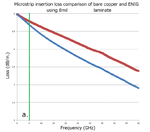youngguns21
Member level 2
I'm a designer having a discussion with a coworker who's background is PCB manufacturing.
On our PCB fab drawings we call out IPC-6018 with an ENIG finish and I questioned him on why we aren't using electrodeposited Ni/Gold.
He replied that we only use SMT chips (no wire-bonding) and the thicker gold would cause Gold Embrittlement. He also stated that the under-cut from the etch on electrolytic Ni/Gold is not as well controlled which will cause the filters I pattern to have a larger tolerance than what I design them for.
Should I be pressing harder for Ni/Au over ENIG? My current board is operating around 5.5G.
If you're a microwave guy/lady, please chime in. Thanks
On our PCB fab drawings we call out IPC-6018 with an ENIG finish and I questioned him on why we aren't using electrodeposited Ni/Gold.
He replied that we only use SMT chips (no wire-bonding) and the thicker gold would cause Gold Embrittlement. He also stated that the under-cut from the etch on electrolytic Ni/Gold is not as well controlled which will cause the filters I pattern to have a larger tolerance than what I design them for.
Should I be pressing harder for Ni/Au over ENIG? My current board is operating around 5.5G.
If you're a microwave guy/lady, please chime in. Thanks
